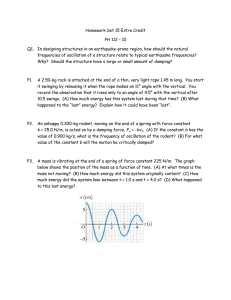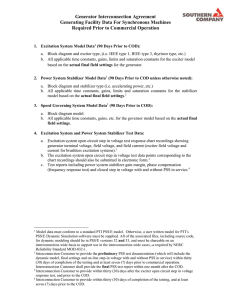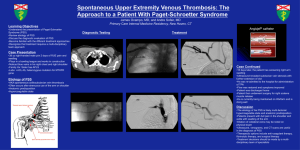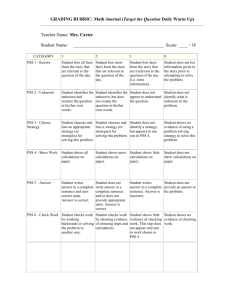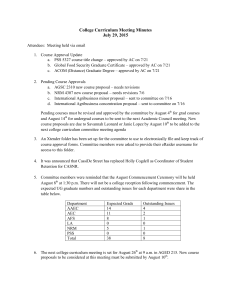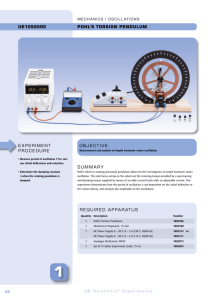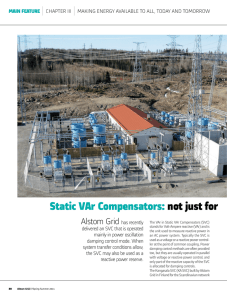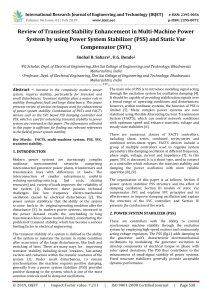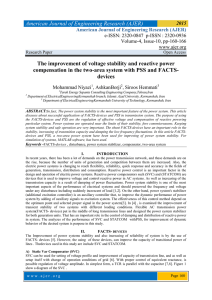3.4 Small-Signal Stability Enhancement Kai Sun Spring 2016
advertisement
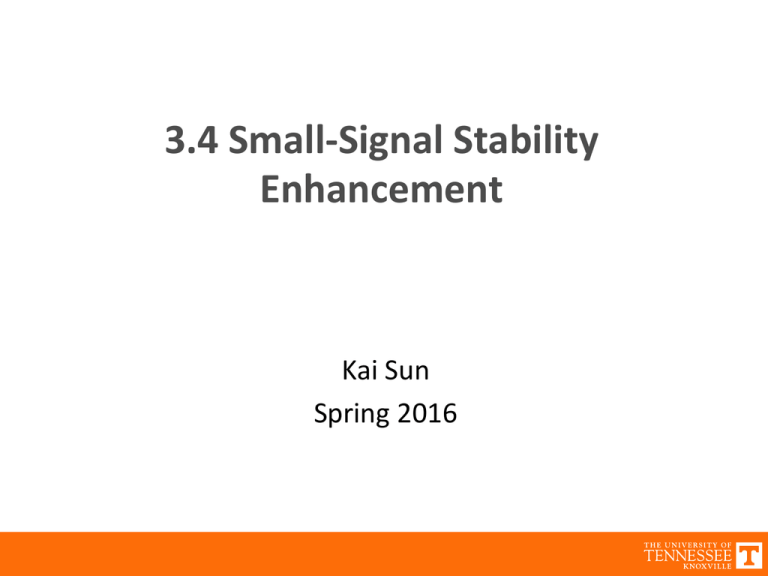
3.4 Small-Signal Stability Enhancement Kai Sun Spring 2016 1 References [1] P. Kundur, Power System Stability and Control, McGraw-Hill, 1994 [2] Joe H. Chow, “Power System Coherency and Model Reduction,” Springer, 2013 [3] S. Zhang, V. Vittal, Design of Wide-Area Power System Dampling Controllers Resilient to Communication Failures, IEEE Trans. Power Systems, v.28, Nov. 2013 2 Objective and Methods •The problem of small-signal stability is usually associated with insufficient damping of system oscillations – The use of power system stabilizers (PSS) to control generator excitation systems is the most cost-effective method, whose idea is to modulate the generator excitation so as to develop a component of electrical torque (i.e. damping torque component) in phase with rotor speed deviation – Additionally, supplemental stabilizing signals may be used to modulate HVDC converter controls and FACTS devices, e.g. SVCs, to enhance damping •The controls used for small-signal stability enhancement should also perform satisfactorily under severe transient disturbances. Therefore, while the controls are designed using linear system techniques, their overall performance is assessed by considering small- as well as large-signal responses 3 Types of PSS (by selection of the input signal) 1. Delta-omega PSS (Shaft speed) – Successfully used on hydraulic units since the mid-1960s – Minimizing the noise from shaft run-out is an important consideration in the design of measurement equipment. – For thermal units, it requires a careful consideration of the effects on oscillations or even instability of torsional modes (typically, >10Hz). Thus, a torsional filter is needed, which has to be customized for each type of generators. 2. Delta-P-omega PSS Torsional filter Advantage: No filter on this main path. 4 3. Frequency based PSS: – It either directly uses the terminal frequency or derive the approximate rotor speed using the terminal voltage and current – The frequency signal is more sensitive to inter-area oscillations, so it is possible to obtain greater damping contributions to inter-area modes of oscillation than would be obtainable with the speed input signal. – Shortcomings include • During a rapid transient, the terminal frequency signal will undergo a sudden phase shift. This results in a spike in the filed voltage. • The frequency signal often contains power system noise caused by large industrial loads such as furnaces. • The same basic limitation as the delta-omega PSS: torsional filtering is still required 4. Digital PSS: – one of the programs of a digital excitation control system 5 Excitation Control and PSS Design [1] 6 Selection of the Excitation System: Tyristor exciter 7 Selection of the Excitation System: Rotating exciter 8 Small-signal stability performance • PSS with the Tyristor exciter 9 Performance under a large disturbance 10 11 Supplementary Control of SVCs • By rapidly controlling the voltage and reactive power, an SVC (Static Var Compensator) can contribute to the enhancement of the power system dynamic performance. • Normally, voltage regulation is the primary mode of control to improve voltage stability and transient stability • Supplementary control with an SVC has the effectiveness in enhancing smallsignal stability depending on the location, input signals and controller design • Placement of an SVC for small-signal stability enhancement – Usually, an SVC may be placed on the dominant oscillation path near the center of oscillation (at the middle of the interconnection between two areas, where voltage swings are the greatest) – For large complex systems, the SVC should be placed at the bus most sensitive to susceptance change (with the highest voltage participation factor) 12 Dominant Inter-area Oscillation Path and Center [2] • About a specific inter-area oscillation mode, the path and center of oscillation are important for monitoring and control purposes – line currents on the dominant oscillation path have the largest values of |PSD| about the mode – The center of oscillation on the path is the bus where the voltage magnitude has the largest |PSD| and the phase angle has the smallest |PSD| about the mode 1 E Y * ( )Y ( ) T T PSD: S y ( ) lim For details, see Chapter 10 (by Vanfretti, Chompoobutrgool and Chow) of Ref. [2] 13 Example on the WECC System •Identify the oscillation path and center on the 0.25Hz mode 14 Effect of SVC on an Inter-area mode [1] 15 Using a supplementary control Modal observability 16 Phase-Lead Compensation G (s) Verr ( s ) I (s) 17 Effect of SVC Supplementary Control 18 Wide-area damping controller resilient to communication failures [3] SVC Both the local and wide-area control signals are fed into the Washout filter as supplementary control signals 19 • Consider Td=100ms communication delay and solve the optimal wide-area and local controllers K1 and K2 20

